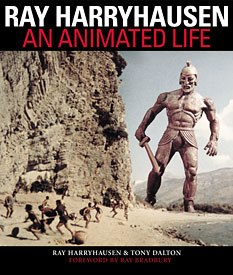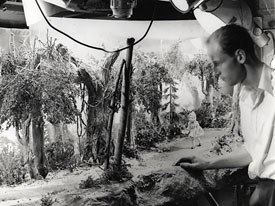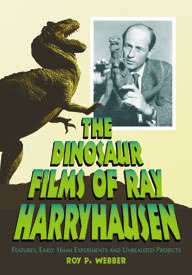Bob Swain and Ron Diamond traveled to Potsdam for Cartoon Movie 2005 and report back with whats hot in the European feature market.

Ray Harryhausens reputation still looms large with the recent release of two new books and a DVD collection. © Sparkhill, Llc.
Ray Harryhausen, a professional stop-motion animator since the 1940s, has hooked at least two generations of fans at Saturday matinees with his mythological and zoological creations. Baby Boomers know him from Seventh Voyage of Sinbad and Jason and the Argonauts; a generation later young Gen-Xers blew their minds on Clash of the Titans. Over the years, Harryhausen has had his hand in over a dozen family-friendly adventures and atomic-age disaster potboilers dropping spinning UFOs on Washington in Earth Vs. the Flying Saucers, mixing grumpy dinosaurs and lighthouses in The Beast from 20,000 Fathoms, putting Baghdads finest on the edge of disaster in a trio of Sinbad movies, and dropping a T-Rex into the Old West in The Valley of Gwangi.
All of Harryhausens movie credits, while not strictly kiddie fare, never push content that would exclude children. Fantasy was Harryhausens genre, and youth was his target audience. Lets face it, only the credulous and/or testosterone-fueled youth could ever fully appreciate One Million Years B.C. Its the Pleistocene, its Raquel Welch with her legs shaved, and its a flying Pteranodon. Not exactly an A-1 science primer for the young ones. But who cares when youre eight years old, sitting in the dark watching a cyclops wrestling a dragon, or three men swordfighting with seven skeletons?
To really geek out on what earned Harryhausen his reputation his legacy of stop-motion Dynamation look no further than the 2004 coffeetable book Ray Harryhausen: An Animated Life. Written by Harryhausen with Tony Dalton, this is a chronology in the artists own words of the what, how, and why of frame-by-frame creature effects from his childhood exercises to his last feature film and beyond.

Harryhausen provides complete production histories for all his features in Ray Harryhausen: An Animated Life.
All the details are here, with tales of monster sticks in live-action sets used to give the actors a place to look, his early experiments with front projection and why he eventually went with rear projection instead, secrets of budget restrictions and recycled model armatures, and reproductions of original storyboards and rare inspirational art in the style of Gustave Dore. The text is overflowing with photos, including behind-the-scenes stills and original posters for all his films.
Harryhausen provides complete production histories for all his features, from early box office disappointments like Mighty Joe Young to runaway hits like Golden Voyage of Sinbad. Though he doesnt dwell as much on acting as he has a right to, he offers many insights for readers inside and outside the trade, and is frank in his admiration and love for all his characters. If the actor doesnt like the villain, after all, neither will the audience, and Harryhausen loved his creatures to pieces.
Practical showbiz perspective abounds, as Harryhausen takes note of box office earnings and critical reviews of each picture. Although he does rely too much on quotes from Variety and Hollywood Reporter then, as now, the trades only reviewed a movies moneymaking potential its worthwhile to consider that, for gross receipts, only eight films in 1953 out-performed The Beast from 20,000 Fathoms.
Heads all over the industry will no doubt be spurred to revisit Harryhausens filmography on home video. Of the 16 feature-length films for which Ray created stop-motion creature effects, all but three are available on DVD. (The holdouts are Mighty Joe Young, Animal World and 3 Worlds of Gulliver). For completists, though, that still leaves a big hole to be filled, a hole that can be plugged nicely with the double-DVD Ray Harryhausen: The Early Years Collection.
Harryhausen is a man of great personal as well as professional longevity, and the proof is in The Story of the Tortoise and the Hare, an unfinished fairy tale for which he animated a new scene in 2002. Begun in 1953, Harryhausen only completed three minutes of this personal project before industry work intruded in the form of monster effects for It Came From Beneath the Sea. Tortoise was only one of a half-dozen one-reel childrens films Harryhausen produced independently on spec, just to see if he could do them. Now all his fairy tales, his Mother Goose stories, and never-before-seen items from his personal archives have been gathered in one collection.
All the material is accompanied by filmed introductions from Harryhausen himself. Much of this hasnt been seen in its complete form for half a century. Its a long time to wait for such an anthology, and fans are eating it up. The public reaction has been fantastic, says DVD executive producer Eric Young. Were going to be the Classic DVD of the month in Premiere in May, and Harry Knowles made us his pick of the month.
The artist has been pining for such an omnibus for years, and the process began thanks to the initiative of Scott MacQueen, long-time archivist and restoration technician. Ray is an old friend, and he had a number of reels of older films, including his workprints and personal copies, MacQueen says. Some were in London, some were out in the garage at his parents house in Pacific Palisades. A hunt got done to find out what was in the possession of the distributor that used to run these films. Someone had them extricated from storage at Rays behest, where they had been pretty much abandoned at a laboratory. Thankfully they got out of that lab and back into Rays hands within a month of the lab going belly-up.
After sorting through the trove of camera originals, intermediates, release prints, mags and optical tracks, MacQueen took notes on what was viable and what was decayed to make sure they had good coverage. After presenting his report to Harryhausen, they realized a major restoration was in order and MacQueen hit up the AMPAS Film Archive for much-needed funding. The Academy was very interested, MacQueen says, what with Ray being a Lifetime Award-winner and one of the great names in animation. They agreed not only to take the films for archival storage but to underwrite new preservation negatives and to restore the films.

Fans are eating up the double-DVD anthology Ray Harryhausen: The Early Years Collection.
MacQueen contacted Mike Pogorzelski, director of the Academy Archive, who assigned preservationist Mark Toscano to oversee the operation. One crucial step was blowing up Harryhausens 16mm originals to 35mm prints, a job eventually completed by Cineric labs in New York. I really love 16mm, but the format is dying out, Toscano says. Kodak just discontinued another one of their Kodachromes and the Ektachrome, and the black and white reversal print stock. These films can have a more extended life in 35mm. And also they can be shown more. Its more expensive, but it seemed worth it.
Disc One of the DVD contains Harryhausens Mother Goose suite, including Little Miss Muffet, Old Mother Hubbard, The Queen of Hearts and Humpty Dumpty. Strung together in one reel, these four charming nursery rhymes with brief intertitles and stock music run the animation gamut from simple to highly sophisticated, as interchangeable character heads provide a variety of expressions. There are also five one-reel fairy tales, Little Red Riding Hood, Hansel & Gretel, Rapunzel, King Midas and The Story Of The Tortoise and the Hare. The fairy tales demonstrate Harryhausens increasing sophistication, from magically braiding hair in Rapunzel to a spreading coat of gold enfolding all the Kings possessions in King Midas.
How to Bridge a Gorge and Guadalcanal are wordless demo films from Harryhausens enlisted days from 1941-5. Bridge demonstrates exactly what it promises in easy-to-follow detail, and at the time Ray hoped he could sell the technique to the Army as a training tool. Guadalcanal depicts the strategic Pacific island being taken first by the Japanese and then by the Americans. This odd beast is fascinating in how it devotes equal time, and more genuine affection, to the building of the temporary Japanese barracks than to their destruction by U.S. forces at the end of the film. Its a study of process, devoid of people, and slightly disturbing surely unintentionally in its depiction of war as a sandbox adventure with toys and no human casualties.
After the war Harryhausen dabbled in commercial advertising, and two artifacts of that era survive here: a Lucky Strike ad and a series of spots for a Los Angeles subdivision called Lakewood. The Lucky Strike ad features packs of cigarettes in a jaunty choreography, and was done on spec in 1945. The Lakewood commercials feature an animated Key with bowler hat and cigar, pitching a new subdivision minutes from Los Angeles with two- and three-bedroom homes available for lease for as low as $46.98 a month.

Harryhausen works on Little Red Riding Hood, which was brought back to its original Kodachrome glory in the new DVD collection. © Sparkhill, Llc.
Over the years, clips from Harryhausens early tests have surfaced in a variety of documentaries. Now theyre being presented unexpurgated for the first time. There are Rays very first experimental animations with cave bears and dinosaurs, done in a post-King Kong burst of enthusiasm using a camera without single-frame advance, which sometimes captured one, two, or three frames with each push of the button. Also present is Evolution, a never-completed epic featuring battling dinosaurs; The Adventures of Baron Munchausen, a short test featuring the Baron being interrogated by a rear-projected Giant whose face fills the screen; and The Elementals, an unproduced feature idea about winged beasts, for which Ray shot and edited a test film where he got carried away in the clutches of his own bat creatures talons.
There are voluminous extras, no surprise since the discs creators, Sparkhill Entertainment, earn their bread producing DVD bonus material for the major studios. Included in the Disc Two supplement is Harryhausens dedication ceremony at the Hollywood Walk of Fame; a short documentary about his statue of explorer David Livingstone; a reunion between Harryhausen, Ray Bradbury, and Forrest Ackerman; the Academys Evening With tribute to Harryhausen; a survey of his bronze sculptures; a feature on the restoration process; and a trip to the Filmmuseum Berlin where many of Harryhausens most famous creatures are on display.
One of Harryhausens unfinished projects from 1953 was The Story of the Tortoise and the Hare, of which he completed only three minutes. It was finally completed in 2002 by Seamus Walsh and Mark Caballero, and the finished short is included here, along with an audio commentary and making of featurette. Walsh and Caballero did a superb job finishing the short in Harryhausens style, matching not only the tone of Harryhausens original fairy tales but also the grain and color palette of the surviving three minutes. The animators of Graveyard Jamboree with Mysterious Mose had just the sense of humor and technical prowess for the job, and Ray himself stepped in front of the camera to animate one scene.
Preservationist Mark Toscano sits for an interview on Disc Two, and his excitement continues today. The thing I was shocked by, before I even looked at the films, was the idea that these were films that Ray made utterly by himself, Toscano says. He had help from his parents in some cases, but the stuff later on, Beast and Argonauts, those are collaborations with a bunch of different people. With these films, I thought, Jeez, these are going to be the films that he did utterly by himself. Ray made these in his twenties, and he was inexperienced, but he was incredibly ambitious and incredibly resourceful. With the equipment he had, he was able to do something really great.
That quality is most apparent in Little Red Riding Hood, a one-reel fairy tale Harryhausen produced in 1950, which bursts through the TV screen like it was made last week. Red Riding Hood is the only one that was able to come back from the Kodachrome original, says Scott MacQueen, and it looks absolutely breathtaking. No grain, sharp and clean its just remarkable.
That Kodachrome is such a beautiful stock, says Toscano. It tended to have somewhat hyperactive colors sometimes. Indeed, the giddy color saturation of Red Riding Hood is almost psychedelic. If you dream in color, this is what your dreams should look like. But beyond the hyper-detailed set dressing and believable acting and weight-shifting of his characters, the scope of the camerawork is the shorts most impressive aspect.
Like I said, this guy was in his 20s, still a novice, Toscano says. He had only made a few films. And hes trying a lot of bold experiments with the camera, like when the wolf goes up the stairs and the camera rises up. I mean, a moving camera incorporated into stop-motion animation? Its quite incredible.
Ray Harryhausen: The Early Years Collection is the first standalone DVD from Sparkhill Productions, formerly known for their home video supplements for the likes of Disney and New Line. They wanted to shoot some interstitials, says executive producer Eric Young, and just as a pro bono thing, I said Come on over to our place, and well do it for you, because Ray is one of my lifelong icons. So we started out helping him out, and the deeper we got into it, we thought, gee, maybe well just put it out ourselves.
That respect is evident in the final product, which is tightly edited, elegantly packaged and well organized. It was a labor of love, Young says. Everybody that worked on it just wanted to see it done right. And Ray had a very concrete idea about how he wanted everything presented, and how he would do the intros and so forth. Its a wonderful archival record.

For the fan who loves Harryhausen and dinosaurs, comes this exhaustive book.
For the more specialized fan, another recent book about Ray Harryhausen called The Dinosaur Films of Ray Harryhausen was published for the first time last year. Written by Roy P. Webber, the 226-page text looks exclusively at Harryhausen projects that included dinosaurs: Evolution, The Beast from 20,000 Fathoms, The Animal World, One Million Years B.C., and The Valley of Gwangi. Its an exhaustive survey from a man who loves Harryhausen and dinosaurs, and it compiles plot summaries, etymological examinations of Rays models vis-à-vis real dinosaurs, shot-by-shot dissections of Rays animation technique, talent biographies, and production histories. Not for general readers, this is everything I mean 100% of what anyone could ever want to know about the great masters dinosaur pictures.
Clash of the Titans, Ray Harryhausens last feature, was released June 12 1981. Two weeks later Dragonslayer came out, and while the latter didnt obliterate the formers success it did represent an example of why stop-motion could no longer carry a movie. Animation supervisor Phil Tippett animated Dragonslayers dragons using armatured puppets whose moves were carried out in full motion with computer-controlled rods, giving them the critical motion blur necessary to fool the eye. Eyes needed fooling more than ever in 1981, a post-Star Wars age when models were no longer allowed to look like models. For Tippett, who no doubt considered Harryhausen an inspiration, even the name of his new technique in Dragonslayer signaled a shot across his idols bow; he called it Go-Motion.
Stop-motion didnt go away Tippett himself later used it in Howard the Duck and Coneheads. But never again could it be the star of a feature film, and Ray retired from moviemaking following Clash of the Titans. He still remains an inspiration for animators everywhere, because frame-by-frame model animation didnt disappear; it only changed media. The brilliant young animation hopefuls of decades to come, now growing up on a diet of Disney DVDs, are in for a nice surprise as they discover the namesake behind the fancy restaurant in Monsters, Inc. The principles of stop-motion are being used every day in computer-animated films, built as they are from virtual models moved a frame at a time like stringless marionettes. The persistence of Ray Harryhausens practices will keep students of the medium coming back to his work meanwhile the soul he bestowed on a cyclops and the sheer storytelling panache of Jason and the Argonauts will keep his catalog alive for everyone else.
Ray Harryhausen: An Animated Life by Ray Harryhausen, Tony Dalton and Ray Bradbury. New York, N.Y.: Watson-Guptill/Billboard, 2004. 304 pages including 691 black-and-white illustrations. ISBN: 0-8230-8402-7 ($50.00).
Ray Harryhausen: The Early Years Collection. Sparkhill DVD. 233 minutes, B&W/Color, not rated. ($29.95).
The Dinosaur Films of Ray Harryhausen: Features, Early 16mm Experiments and Unrealized Projects by Roy P. Webber with forewords by Jim Aupperle and Bill Maylone. Jefferson, N.C.: McFarland & Company, Inc. Publishers, 2004. 240 pages including 171 photographs & illustrations. ISBN 0-7864-1666-1 ($45.00).
Taylor Jessen is a writer living in Burbank. He would like to apologize for invading Manchuria in 1931, and would like citizens to know that they can have their national currency back if they want it.







